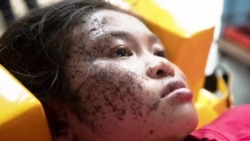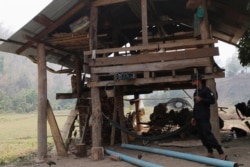On March 27, reports surfaced that Myanmar’s military began airstrikes in the country’s southeastern Karen state near the Thai border.
Reuters described the bombing as “the most significant attack for years in the region.” The airstrikes drove an estimated 7,000 people from their homes.
The area is under the control of the Karen National Union (KNU), the political wing of the Karen people’s insurgent group.
On March 29, an estimated 3,000 people fleeing the assault reportedly crossed the border into Thailand’s Mae Hong Son province, Thai news outlet Khaosad English reported. Khaosad said the attack may have been in retaliation for the Karen rebels’ seizure of a military outpost on March 28.
The airstrikes fit into a pattern of escalating violence across the country following the coup carried out by the Myanmar Tatmadaw (military) on February 1. Amid widespread protests, the Myanmar nonprofit Assistance Association of Political Prisoners estimates that 521 people have been killed as of March 30.
On March 27 alone, Myanmar security forces killed 114 people in what has been described as the bloodiest day of the military coup.
On March 30, Thai Prime Minister Prime Minister Prayut Chan-o-cha said Thailand would not block entry for Myanmar refugees entering the country.
"Thailand will not turn them away," the Bangkok Post quoted Prayut as saying. "When they are in trouble, we will not deny them entry to our country.”
He further claimed there had yet to be an influx of refugees:
“We asked those who crossed to Thailand if they have any problem in their area. When they say no problem, we just asked them to return to their land first. We asked; we did not use any force.”
That is misleading.
In fact, evidence has emerged that Thai border guards are forcing people back across the border. Whether that is being done with the central government’s approval is unconfirmed. What’s more, reports of Karen civilians injured in airstrikes undermines claims the there are no problems in the affected areas.
On March 30, Sitthichai Chindaluang, the governor of Mae Hong Son, a Thai province which shares a border with Karen state, also told Thai PBS World that most of the fleeing Karens had returned to Myanmar “voluntarily.”
The governor added that Thai troops from the Naresuan Task Force, responsible for border security in Mae Hong Son, had been tasked with looking after the Karen refugees and persuaded most of them to return home.
The next day, Thai authorities claimed some Myanmar refugees who entered Thailand while fleeing airstrikes “voluntarily” went home.
"A group of 56 people who escaped fighting have voluntarily crossed back into Myanmar by five mid-sized boats ... by 9:50 am," AFP reported, citing a notice released by provincial authorities.
The notice said another 201 refugees still in Thailand had also agreed to voluntary return: "Most of them are children, women, elderly and patients who will return to Myanmar."
However, Sangkhom Khadchiangsaen, chief of Mae Sariang District in Mae Hong Son province, said it was government policy to block those entering Thailand.
“All agencies should follow the policy of the National Security Council, which is we need to block those that fled and maintain them along the border,” Reuters cited Sangkhom as saying.
“The military has the main responsibility in managing the situation on the ground and we must not allow officials from UNHCR (United Nations High Commissioner for Refugees), NGOs or other international organizations to have direct contact and communication. This is absolutely forbidden.”
Videos have surfaced purporting to show people from Ei Htu Hta internally displaced person (IDP) camp, in Papun District, Karen state, interacting with Thai border patrol forces after fleeing to the Thai side of the border.
Myanmar’s independent Irrawaddy News outlet also released footage reportedly showing Thai border police forcing back Karen villagers who crossed into Thailand fleeing airstrikes in Hpapun District, Karen state.
The Voice of America (VOA)’s Burmese service was able to confirm that the people seen fleeing in the videos are Karen villagers. The service also confirmed that the uniformed individuals seen in the videos are Thai border police.
Based on the video footage alone, the exact nature of the interactions between Thai security forces and the refugees is uncertain.
However, a VOA Burmese service reporter based in Mae Sot reported that Karen refugees were pushed back from the Thai side, although a few sick and wounded individuals have been cared for by local Thai medics.
Irrawaddy also reported on March 30 that seven people wounded in Myanmar regime airstrikes had been injured and taken to a nearby hospital in Thailand.
The Bangkok Post, citing Reuters, reported on March 30 that more than a dozen people were allowed to cross the border that day to receive medical treatment.
Prominent Thai journalist Pravit Rojanaphruk and others posted photographs allegedly showing Thai security forces putting up razorwire "to prevent Karen refugees fleeing Burmese aerial bombing to Thailand.”
The Karen National Union released a statement saying it was “very troubled to hear” that Thai authorities had been forcing civilians to return to the IDP camp in Myanmar in the wake of the airstrikes. “We call on the Thai authority to accept them on humanitarian grounds,” the KNU said in a statement.
The European Karen Network released a statement calling on Thailand’s foreign ministry “to stop forced deportation of Karen refugees” back to Myanmar, which it said violated international refugee law.
According to the Bangkok Post, Thailand hosts approximately 100,000 refugees from Myanmar at camps along the border.
Earlier this month, the Thai military was accused of providing rice and other food supplies across the border to Myanmar soldiers after Karen insurgents cut off supply routes for Myanmar military units.
At the same time, rights groups alleged humanitarian aid for displaced Karen villagers was being blocked.
The Three Brotherhood Alliance — consisting of three ethnic rebel groups that does not include the KNU — released a statement calling on Myanmar’s military to stop killing civilian protestors and threatening to unite with citizens opposed to military rule.









